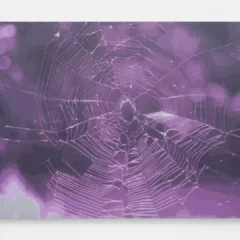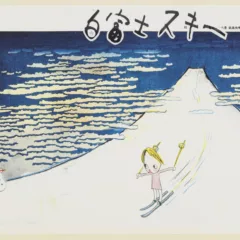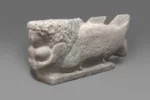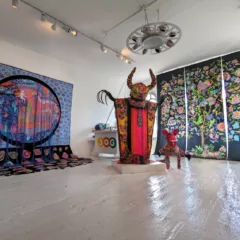—Multi-media works and some complicated printmaking are under discussion as Andrea visits an artist’s studio.–the Artblog editors———————–>
Sometimes a single artwork is compelling enough that I want to know more about its maker. At a two-person exhibition at Tiger Strikes Asteroid late last year, I was intrigued by a very large, subtly-layered work on paper that featured an outlined image of a yurt. I could find no clues as to how it was made. When the artist, Alexis Granwell, said it was a print created with multiple intaglio processes, I was startled. Intaglio usually leaves not only a plate mark, but a very distinctive quality of line because of how the ink sits on the paper=s surface, and I could see neither. She offered to show me how she worked and I happily accepted.
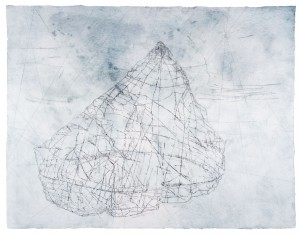
65″ x 48″,
drypoint, monotype & collograph on Kozo, photo: Rebecca Mott
From painting to printmaking
Granwell’s background is in painting, and she uses printmaking in a highly unorthodox manner. She isn=t interested in creating multiples, one of the cardinal motivations for printmaking. Most of her work consists of unique, multi-color prints, often re-using a plate in combination with varied second and third plates or surface wiping for additional colors. The artist brought out several impressions that employed the plate with the black, stippled outlines of the yurt I had seen, and I had the feeling of observing the structure in different atmospheric conditions, rather like Monet’s serial paintings of haystacks. And unlike most print-makers who can delegate the actual printing to a specialist, Granwell does much of her creative work during the printing process itself. She admits that her working method drives the printers crazy.
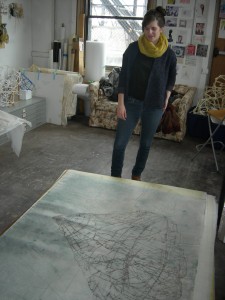
Working with printmaking’s tighter constraints
The freedom of form and color which painting offers overwhelmed Granwell. She found that printmaking reduced her options, and she is more comfortable working within tighter constraints. This reminds me of a remark attributed to Igor Stravinsky, that true freedom comes from setting parameters. Color printing involves a process of clearly-divided steps. Each color requires its own plate and a separate pass through the press, and this clearly suits Granwell=s thinking process. Most of the work she showed me involved four colors, although I was hard pressed to distinguish them, even after she explained what each involved.
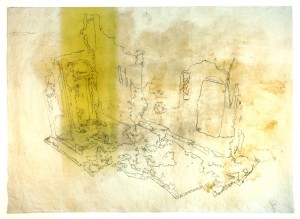
48″ x 60″ drypoint, monotype and collograph on Kozo
photo: Rebecca Mott
Making your own paper
Granwell=s palimpsestic imagery actually begins with the paper, which she makes herself in a laborious process which takes half a day to produce a single sheet. She uses a Tibetan technique and usually works with abaca fiber, from the trunk of a type of banana. Her paper has ragged edges, areas of intentional loss or holes (from drips of water) and mottled and varied texture because of the way the abaca fibers clump. She can draw with the pulp. In order to use paper so large she had to find a suitable press, which she did at AS220, a community art center in Providence, R.I., whose press has a ten-foot bed.
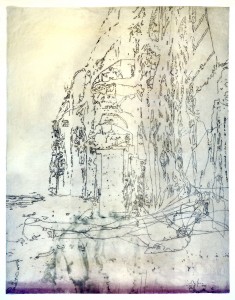
photo: Rebecca Mott
Much of Granwell’s printing is so subtle that it is impossible to distinguish imagery created by the textured paper from that created by ink.
The four-color prints I saw involved one plate using spit bite, to create black outlines, a second plate using drypoint, a third with surface wiping and a fourth with brayer roller marks. These last two are a monotype technique, where the inked areas are not fixed in the plate, but created by hand with each impression. Their effects often look like washes of watercolor, with the soft edges of Frankenthaler=s stains. The hand-made abaca paper takes the ink quite differently from machine-made papers. The irregular paper often emerges from the press with large wrinkles, an effect the artist happily accepts. Granwell generates each step in response to the often-unforseeable result of the previous one. Her creativity is in orchestrating the mixture of planning and accident. Because of this, she retains less than a third of the prints she makes.
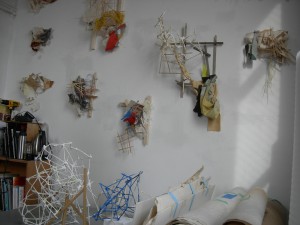
All of Granwell=s printed imagery evokes landscape.
Some prints show buildings, while others take the form of building plans or maps. Vernacular structures of every sort intrigue her, hence the yurt, as do many sorts of ruins. The interest in ruins accords well with the qualities of her paper, which has the irregularities of timeworn artifacts, and some of her printed effects, which resemble stains accrued with age.
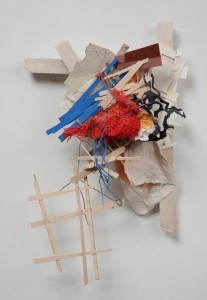
16″ x 11″ x 5″ mixed media, photo: Aaron Igler
Working in three dimensions
Granwell has also been working on a series of small, three-dimensional pieces, most of which are wall-hung reliefs. All of them have lattices of geometric forms, and read as drawings in space. She creates the three-dimensional work in a step-by-step process of adding materials that parallels the discrete steps and layering of color printmaking. The tabletop works, made of coated (and sometimes painted) wire, are constructed in cell-like, intersecting units which form nodes where they meet. Some of them also have a wooden supporting structure and all the tabletop work is restricted to one or two colors.
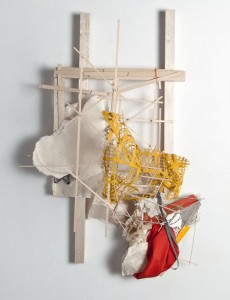
25″ x 15″ x 9″ mixed media, photo: Aaron Igler
The wall-hung pieces are particularly promising. They have wooden armatures, regular lattices created from thinner, wooden sticks, and some have areas of the cell-like wire structures used in the tabletop work. Granwell adds various scavenged materials to these forms: bunched cloth, bits of wire, scraps of cut cardboard, torn and crumpled paper, plastic mesh. Many of these are brightly-colored, and her subtle arrangements of small amounts of intense color are a clear legacy of her painting. She combines the regularity of industrially-made materials with irregular forms that are not so much organic as distressed. They carry a history of prior use and obsolescence. The wall pieces employ angles that have the axiometric quality of Russian Constructivist art. It is striking that works cobbled-together of such irregular, cast-off materials appear so carefully-calibrated and balanced. They are elegant in their restraint.
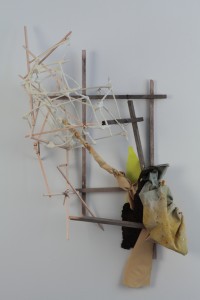
20″ x 15″ x 18″ mixed media, photo: Aaron Igler
I am always intrigued by the source material in an artist’s studio: the books, exhibition announcements, photographs, post cards, and assorted objects kept at hand for reference. I was not surprised to find images of work by Eva Hesse, Louise Bourgeoise, and Lee Bontecue on Granwell’s studio wall. All of them straddled painting and sculpture, and incorporated soft materials into three-dimensional work. They are suitable exemplars for Granwell’s project of painting by other means.



